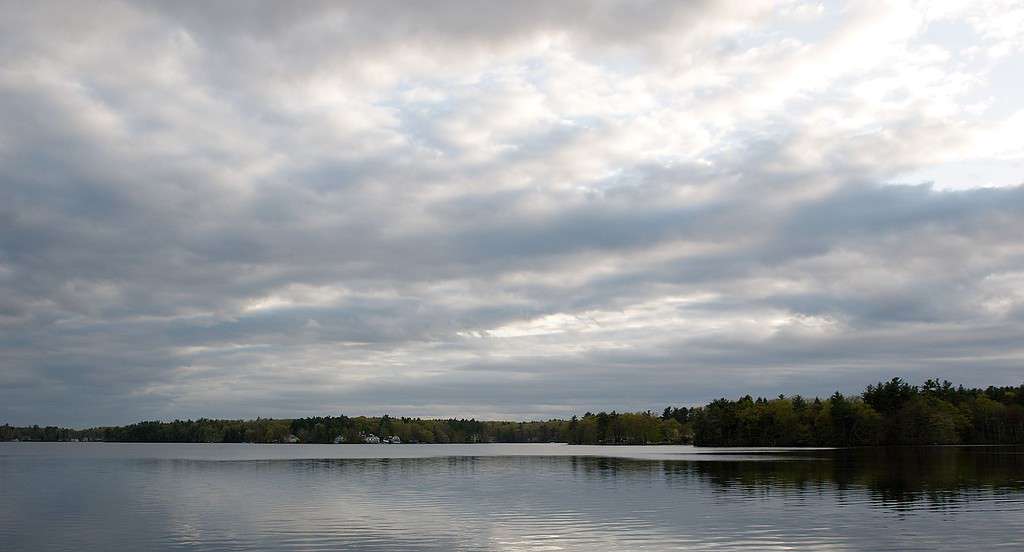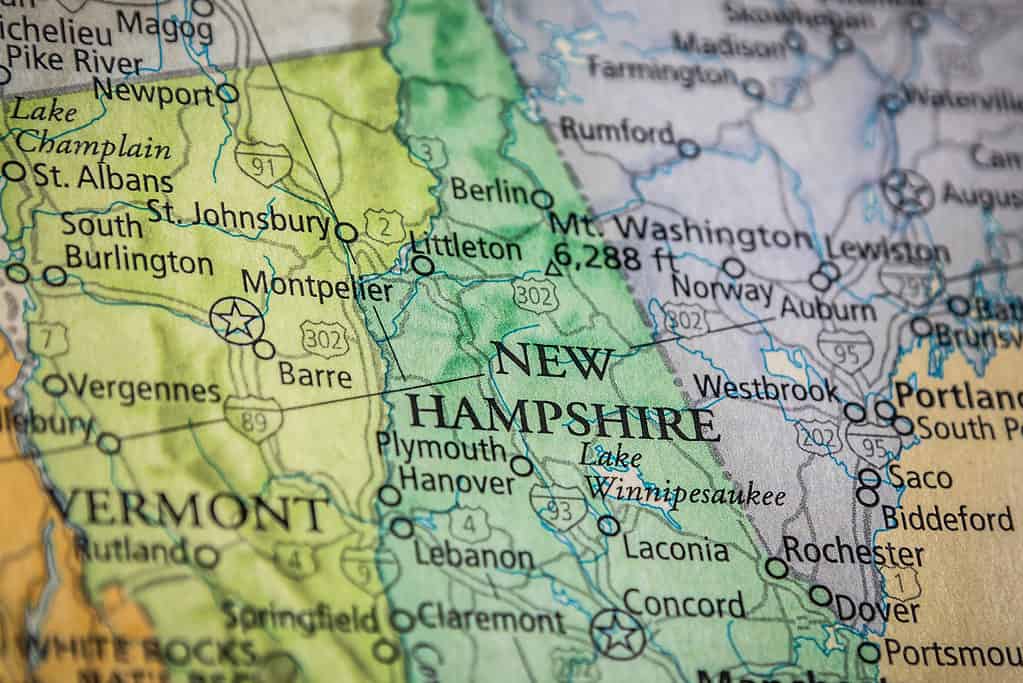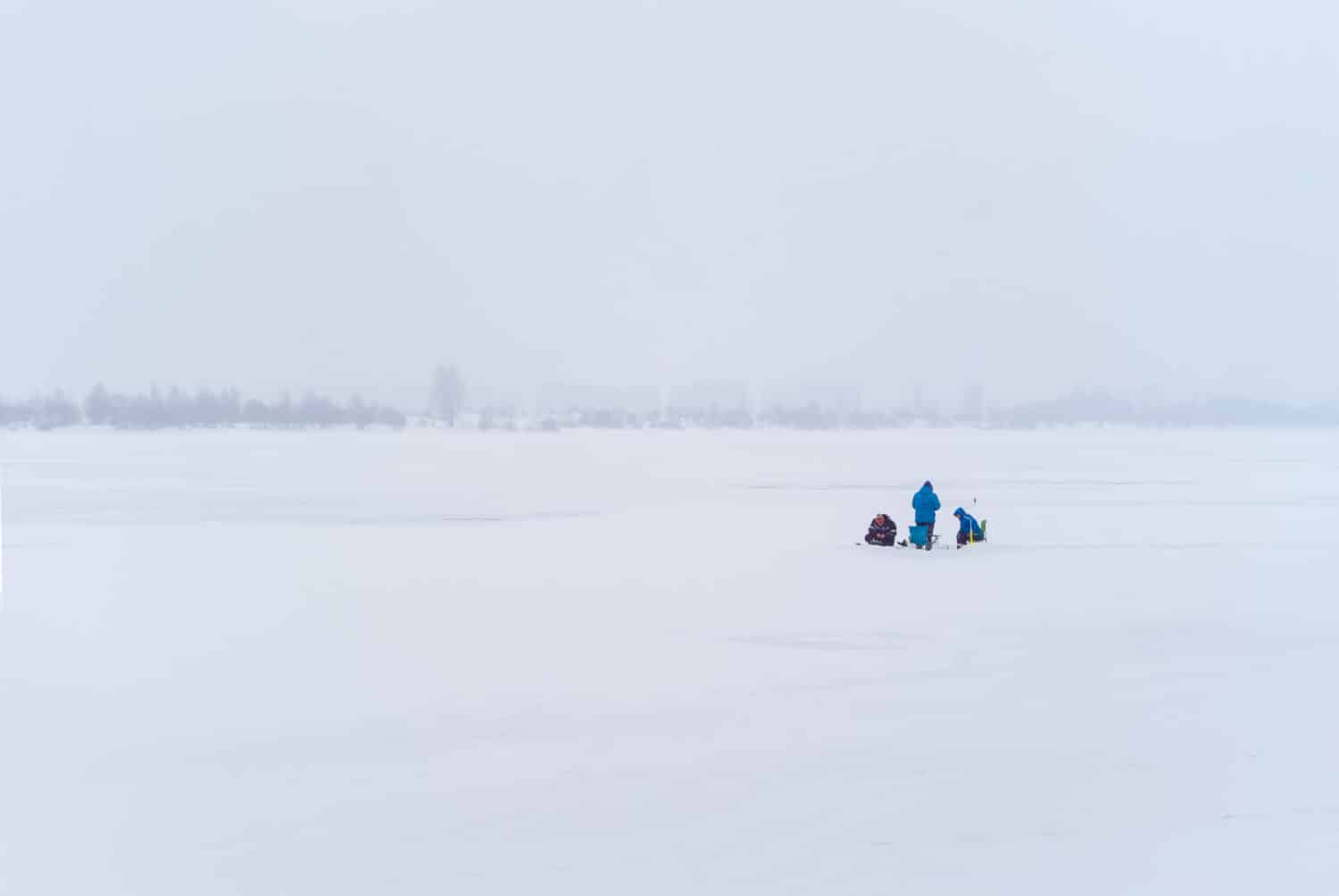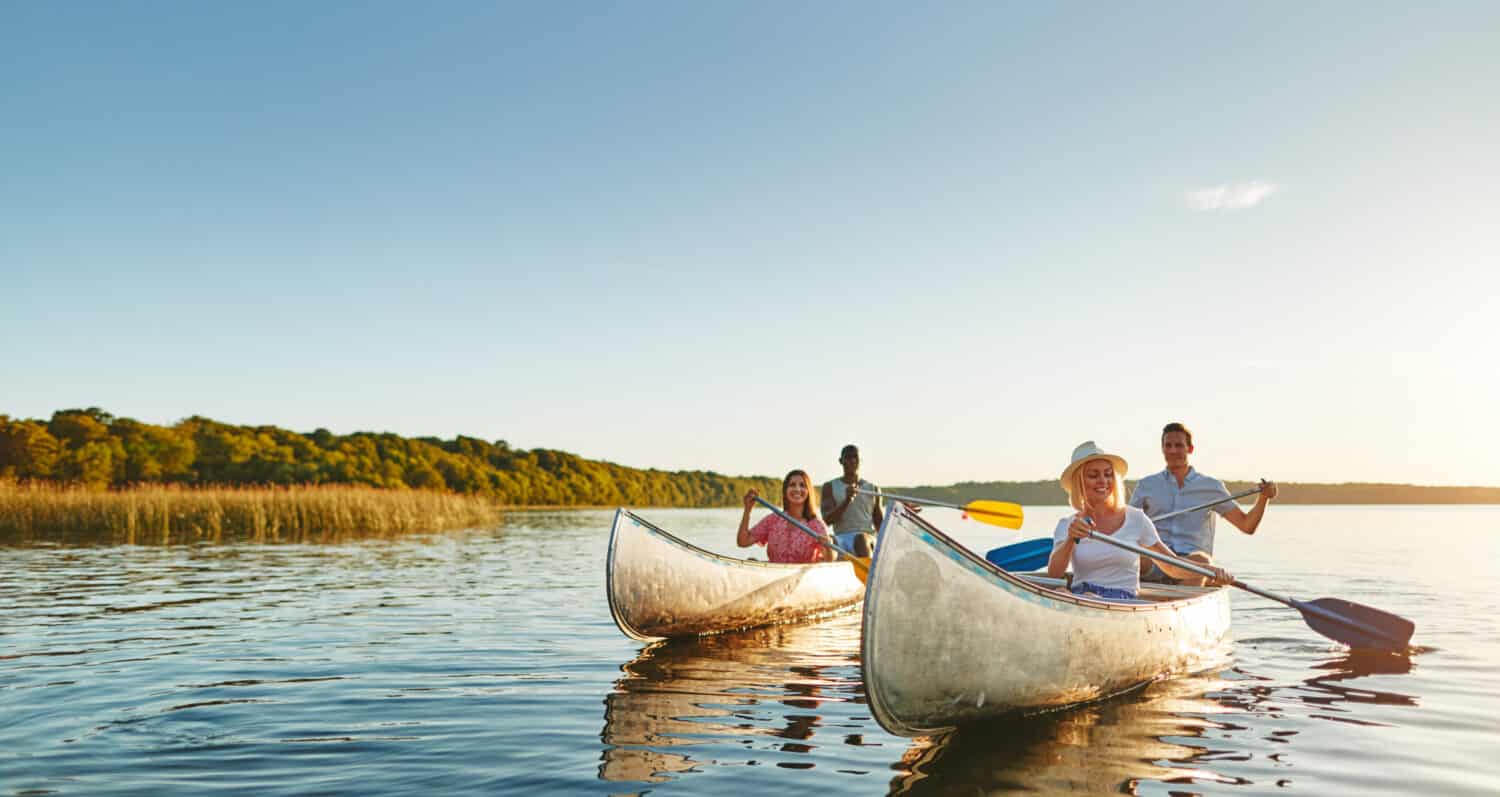Canobie Lake is a picturesque oasis of natural beauty and recreational bounty. From its tranquil waters to the surrounding lush scenery, the lake offers many year-round activities. Whether it’s the allure of fishing for bass, boating on calm waters, enjoying winter sports, or exploring the amusement park on the east shoreline, Canobie Lake caters to diverse interests and passions. It is rich in history and an integral part of the local community.

Canobie Lake resides in southern New Hampshire.
©Fletcher6 / CC BY-SA 3.0 / https://creativecommons.org/licenses/by-sa/3.0 – License
Location
Canobie Lake resides in Rockingham County in southern New Hampshire. The lake resides between the towns of Windham and Salem.

Canobie Lake formed during the last Ice Age.
©BestStockFoto/Shutterstock.com
History
Canobie Lake is a primarily spring-fed lake. Its history over the centuries varies and demonstrates how Canobie Lake has stood as a valuable natural resource for the surrounding residents.
Before European settlements, the area in which Canobie Lake resides was inhabited by Native American tribes, predominantly the Pennacook people. They revered the lake for its abundant fish stocks and serene beauty and lived in harmony with their environment.
Fast forward to the 17th century, European settlements took root. With time, the region surrounding Canobie Lake underwent significant transformations. Farms sprouted around its banks, and the lake’s placid waters provided a reliable irrigation source.
In the early 19th century, Canobie Lake started to attract visitors as a recreational destination. Its scenic beauty and proximity to the growing cities of Boston and Lowell made it an ideal getaway spot. The lake became known for its clean waters, lush surroundings, and opportunities for boating and fishing. However, the Industrial Revolution left its indelible mark on Canobie Lake. Mills emerged on the lake’s banks, harnessing the power of its waters to drive the wheels of industry. While ushering in economic growth, this phase impacted the lake’s natural beauty. Industrial pollution took a toll on its waters and biodiversity.
Canobie Lake Park
The lake’s course was altered once again in the early 20th century. Trolley car transportation was growing and expanding across the country. The Hudson, Pelham & Salem Railways (HP&S), who had their hands in the trolley car business, opened Canobie Lake Park on the east shore of Canobie Lake to serve as a pleasure resort and increase business. HP&S, along with other smaller railway companies, combined their pursuits under one business named Massachusetts Northeast Street Railway Company (MNRC). The transformation of Canobie Lake from an industrial site to a recreational hub revitalized its waters. It reestablished it as a beloved fixture of New Hampshire’s landscape. The amusement park quickly gained popularity, attracting thousands of visitors annually. New rides and attractions were added over time, contributing to the park’s growing allure. By the 1920s, they hit hard times due to the booming automobile industry. And by 1929, they closed for business, and so did Canobie Lake Park.
In 1932 a man named Patrick J. Holland acquired Canobie Lake Park. He hired a team to bring it back to its former glory, renovate it with the times, and incorporate amusement park rides. After roughly two months, the park reopened to the public. Over the proceeding decades, the park experienced a flux and flow of growth due to ownership changes and extreme weather events while evolving further into an amusement park. Its Dancehall Theater also became an entertainment destination and hosted many famous names from the 1930s to the 1950s. Canobie Lake Park, from its inception, has proved to be an incredible economic importance to the local economy.
A Lake of Significance
Despite the ebb and flow of its past, Canobie Lake itself never lost its ecological significance. State entities have implemented numerous conservation efforts to restore and protect the lake’s biodiversity. Today, the lake is a habitat for a wide range of species and contributes to the regional ecosystem.
As an overview, Canobie Lake’s history is a narrative of transformation and resilience. From its early days as a treasured natural resource for Native American tribes and European settlers, through the industrial upheavals, to its rebirth as a recreational and ecological oasis, the lake reflects the broader historical shifts of the region. Today, besides its amusement park, Canobie Lake remains a popular spot for outdoor activities. Locals and tourists alike can enjoy boating, fishing, swimming, and more. The surrounding areas also offer beautiful walking trails and picnic areas, allowing visitors to enjoy the area’s natural beauty.

Boating is a popular recreational activity on Canobie Lake.
©Greens and Blues/Shutterstock.com
Size
According to the New Hampshire Department of Environmental Services (NHDES), Canobie Lake’s surface area spans approximately 375 acres.
The lake extends about 1.5 miles in length and is approximately half a mile at its widest point. Though is also worth noting that at the widest point, the lake has two arms that, if measured, combine to produce a width of roughly 1 mile at the lake’s center.
These dimensions contribute to Canobie Lake’s scenic allure and make it an ideal habitat for a wide variety of aquatic and terrestrial life forms. The lake’s size enables it to support abundant wildlife in and around the lake while offering ample opportunities for recreational activities.
Depth
Canobie Lake boasts a maximum depth of about 40 feet, providing ample room for a diverse range of aquatic life to flourish.
As with any freshwater body, Canobie Lake’s temperature varies with the changing seasons. During the sweltering summer months, surface water temperatures can reach 80 degrees Fahrenheit, offering swimmers and boaters a warm, welcoming embrace. Conversely, in winter’s icy grip, the lake can cool down to just above freezing point, forming a thick sheet of ice on its surface.
Wave size at Canobie Lake, like most inland bodies of water, typically depends on wind speed and direction. Under normal conditions, waves are relatively small. However, they can reach a couple of feet in height during strong wind events. Nevertheless, the lake is generally calm, providing a serene and safe environment for recreational activities.
Water Level
Canobie Lake has a maximum level of roughly 220 MSL. Similar to other freshwater bodies, its water levels fluctuate throughout the year by approximately two to three feet.
The water level in Canobie Lake typically peaks during the spring, when the snowmelt from surrounding higher ground courses into the lake, swelling its banks.
As summer rolls in, evaporation due to warmer temperatures coupled with reduced rainfall can lead to a gradual decline in water levels. Autumn often sees a slight rebound thanks to increased precipitation. One winter settles in, the lake’s surface freezes over, which puts a pause on significant water level changes until the arrival of the following spring thaw.

Winter activities at Canobie Lake include ice fishing, cross-country skiing, and snowshoeing.
©Greens and Blues/Shutterstock.com
Fishing
The tranquil waters of Canobie Lake teem with a wide array of fish, making it an exciting destination for nearby anglers of all levels.
Rules and regulations play a vital role in preserving the lake’s ecological balance while ensuring fair and ethical fishing practices. The New Hampshire Fish and Game Department enforces specific regulations, such as daily bag limits, size restrictions, and gear restrictions. All anglers aged 16 and above are required to have a valid New Hampshire fishing license.
Fish habits and state regulations dictate fishing seasons at Canobie Lake. However, year-round fishing is possible, with ice fishing being a popular pastime during the freezing winter months.
Additional facilities around Canobie Lake, such as bait and tackle shops and boat rental services, add to the convenience for anglers. However, it’s worth noting that fishing is not allowed in the areas immediately adjacent to Canobie Lake Park during the amusement park’s operating season.
Largemouth Bass
The largemouth bass is a prized catch in Canobie Lake, known for its explosive strikes and powerful runs. They’re most active in the warmer months, from late spring to early fall. Pre-spawn and spawn periods (typically April to June) can be exciting when the bass move to shallower waters to lay their eggs.
Smallmouth Bass
The smallmouth bass is famous for its fighting spirit and aerial acrobatics when hooked. They thrive in cooler waters compared to their largemouth counterparts. Optimal fishing conditions for smallmouth bass usually occur in early spring and fall when the water temperature ranges from 60 to 70 degrees Fahrenheit.
Chain Pickerel
Chain pickerel are aggressive predators, making them exciting to catch. They are known for their distinctive chain-like patterns. Moreover, they are most active during colder months, making late fall and winter the ideal time for pickerel fishing. They also bite well during early spring before the water temperatures rise too high.
Bluegill Sunfish
Bluegills are a popular catch for anglers of all ages due to their abundance and willingness to bite. They are active throughout the warm months but are most easily caught during their spawning period in late spring and early summer when they nest in shallow water.
Other Notable Fish
Canobie Lake is home to other notable fish as well. These commonly seen fish include the brown bullhead, black crappie, rainbow trout, brook trout, and pumpkinseed.

Bluegill sunfish are a popular fish you can find in Canobie Lake.
©Stacey Ann Alberts/Shutterstock.com
Geology
Like many lakes in New Hampshire, Canobie Lake owes its existence to the last Ice Age. This Ice Age occurred around 10,000 to 12,000 years ago.
Massive glaciers advanced over much of North America as the Ice Age progressed. These glaciers, some over a mile thick, had a profound sculpting effect on the landscape. As they moved, they scraped and gouged the underlying bedrock, creating depressions that would later fill with meltwater when the glaciers retreated, giving birth to many lakes and ponds.
It is believed that Canobie Lake formed during this process, known as glacial carving. When the vast Laurentide Ice Sheet, which once covered much of New Hampshire, started to melt at the end of the Ice Age. As a by-product, it left behind basins that gradually filled with water, resulting in the formation of lakes such as Canobie Lake.
Over thousands of years, the lake has changed and adapted due to natural processes. Sediment deposition, erosion, and the activity of the local flora and fauna have all shaped the lake we see today.
Moreover, the underlying bedrock, primarily made up of granite (the state rock of New Hampshire), contributes to the lake’s water chemistry and influences the types of plants and animals that can thrive in and around the lake.

Canobie Lake was formed during the last Ice Age.
©Ground Picture/Shutterstock.com
Boating and Other Activities
Canobie Lake is a beauty to behold and a recreational paradise that serves as the heart of various recreational activities, drawing locals and tourists alike who yearn for a rendezvous with nature.
Boating
Boating stands out as one of the most favored activities at Canobie Lake. The calm waters make it an ideal spot for both power boating and paddle sports like kayaking and canoeing. Whether you prefer the excitement of speeding across the water or the tranquility of paddling in sync with nature’s rhythm, Canobie Lake has you covered. Please note that local regulations require all boaters to follow safety guidelines and respect no-wake zones.
Amusement Park
Adjacent to Canobie Lake on its east side is Canobie Lake Park, a famous amusement park that adds a unique flavor to the area’s recreational offerings. While it’s not a national or state park, its vibrant mix of over 85 rides, games, and attractions provide a contrasting adrenaline rush to the tranquil lake experience.
Swimming
As temperatures rise, the lake becomes a sought-after swimming destination. Its warm waters offer a refreshing escape from the summer heat. However, it’s important to remember that swimming is allowed only in designated areas, and adhering to safety measures is paramount.
Ice Fishing
Come winter, Canobie Lake transforms into a winter wonderland. Ice fishing is popular during the cold months, allowing anglers to continue pursuing their passion amidst a snowy backdrop. It’s common to see groups huddled around drilled holes on the lake’s icy surface, fishing rods in hand.
Cross-Country Skiing and Snowshoeing
Additionally, cross-country skiing and snowshoeing along the lake’s surrounding trails offer delightful ways to enjoy the winter scenery. These activities provide a great workout and allow individuals to immerse themselves in the serene beauty of a New Hampshire winter.
Hiking and Birdwatching
Canobie Lake’s richness isn’t limited to its waters. It is fringed by beautiful trails that beckon hikers and bird watchers. These trails offer a glimpse into the region’s diverse flora and fauna, proving that Canobie Lake’s beauty extends beyond its waters.

There are numerous nature trails around Canobie Lake.
©Ground Picture/Shutterstock.com
Camping
While there are no campgrounds directly on Canobie Lake due to its location, the surrounding region boasts several scenic camping locations. For instance, the nearby Tuxbury Pond RV Resort offers a serene escape with beautiful views and ample amenities, including RV and tent sites, a swimming pool, and a fishing pond. Another popular option is the Wakeda Campgrounds, located a bit further but renowned for its charming, wooded environment and family-friendly facilities.
As for the best seasons to camp, summer is a favorite for many, with the warm weather perfect for a myriad of outdoor activities such as hiking, swimming, and fishing. The vibrant foliage of fall offers a different appeal, painting a stunning, colorful backdrop. While camping during these seasons offers unique experiences, booking in advance is crucial, as the limited spots nearby can fill up quickly. Winter camping isn’t as popular due to New Hampshire’s cold temperatures. Still, it is possible. Spring and autumn, although often overlooked, are fantastic times to enjoy the rebirth of the landscape or splendid fall foliage.
Remember, while camping near Canobie Lake, respect the Leave No Trace principles to help preserve the area’s natural beauty. Moreover, Leave No Trace signifies respecting wildlife, being considerate of other visitors, and picking up after yourself, ensuring you leave your campsite as you found it.
Where is Canobie Lake Located on a Map?
Canobie Lake makes its home between the towns of Salem and Windham in Southern New Hampshire. It is known for its rich history and welcoming community. The lake sits near the state’s southeastern corner, snug against the Massachusetts border. It is approximately 35 miles north of Boston, MA, and around 20 miles south of Manchester, NH, making it conveniently accessible for day-trippers and weekend explorers alike.
The photo featured at the top of this post is © Ground Picture/Shutterstock.com
Thank you for reading! Have some feedback for us? Contact the AZ Animals editorial team.







